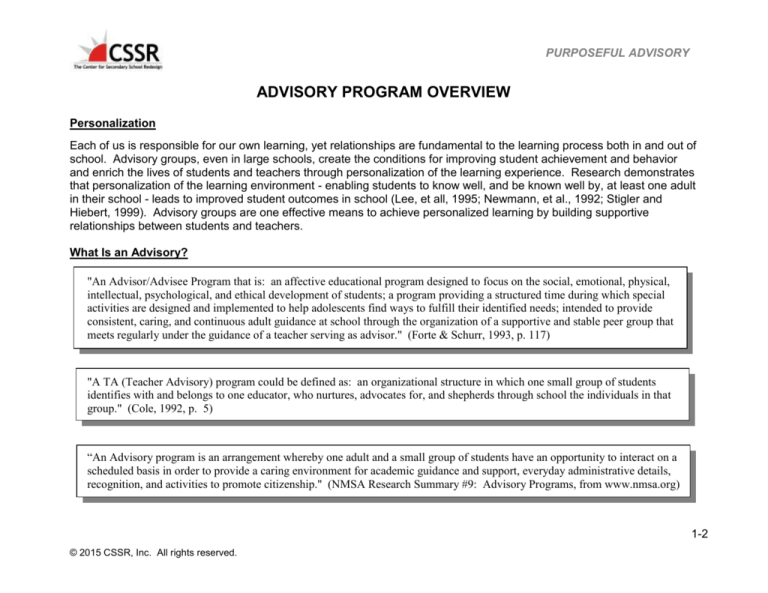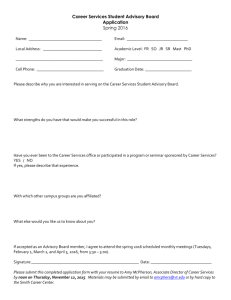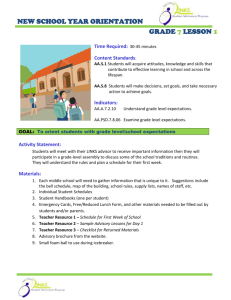
PURPOSEFUL ADVISORY
ADVISORY PROGRAM OVERVIEW
Personalization
Each of us is responsible for our own learning, yet relationships are fundamental to the learning process both in and out of
school. Advisory groups, even in large schools, create the conditions for improving student achievement and behavior
and enrich the lives of students and teachers through personalization of the learning experience. Research demonstrates
that personalization of the learning environment - enabling students to know well, and be known well by, at least one adult
in their school - leads to improved student outcomes in school (Lee, et all, 1995; Newmann, et al., 1992; Stigler and
Hiebert, 1999). Advisory groups are one effective means to achieve personalized learning by building supportive
relationships between students and teachers.
What Is an Advisory?
"An Advisor/Advisee Program that is: an affective educational program designed to focus on the social, emotional, physical,
intellectual, psychological, and ethical development of students; a program providing a structured time during which special
activities are designed and implemented to help adolescents find ways to fulfill their identified needs; intended to provide
consistent, caring, and continuous adult guidance at school through the organization of a supportive and stable peer group that
meets regularly under the guidance of a teacher serving as advisor." (Forte & Schurr, 1993, p. 117)
"A TA (Teacher Advisory) program could be defined as: an organizational structure in which one small group of students
identifies with and belongs to one educator, who nurtures, advocates for, and shepherds through school the individuals in that
group." (Cole, 1992, p. 5)
“An Advisory program is an arrangement whereby one adult and a small group of students have an opportunity to interact on a
scheduled basis in order to provide a caring environment for academic guidance and support, everyday administrative details,
recognition, and activities to promote citizenship." (NMSA Research Summary #9: Advisory Programs, from www.nmsa.org)
1-2
© 2015 CSSR, Inc. All rights reserved.
PURPOSEFUL ADVISORY
The Theory Behind Advisory Programs: What the Literature Says
"We believe that everyone at the school should be accorded the respect of being known well, that the particular strengths and
weaknesses, worries and hopes, of each young person should be understood and accommodated. Personalization is not just
courtesy; it is the necessary condition for efficient and effective teaching of each student." (Sizer, 1992, p. 143)
"If even one person in a school knows him well enough to care, a student's chances of success go up dramatically. In small
groups that can focus on a range of subjects, teachers and students are forming new bonds and setting new standards for a
personal education…More, advisory groups can promote the principles of unanxious expectation, trust, and decency in
students' relations with their teachers and others, both on school and outside it." (Cushman, 1990, p. 1)
"To have an opportunity for closer relationships between advisor and student, to build interpersonal and social skills and
integrate them into real-life situations, to develop a sense of belonging using a small group setting and allowing the advisor
to be actively involved in the total development of their students; socially, emotionally, as well as academically."
(Dickinson et al., 1998, p. 3)
"If teachers are perceived by students as caring and interested in them, they are more likely to be inspired and to enjoy
going to school; they feel encouraged and try harder." (Myrick, 1998, p. 15)
© 2015 CSSR, Inc. All rights reserved.
1-3
PURPOSEFUL ADVISORY
Successful Advisory Programs: What the Research Says
"In general, students who do not feel an attachment to school personnel tend to have poorer attendance and to drop out more
than students who perceive that they are part of a supportive, caring school environment (Wehlage, Rutter, Smith, Lesko, &
Fernandez, 1989). Moreover, a positive psychosocial climate between teachers and students appears to improve academic
achievement (Flanders, 1965; Rutter, Maughan, Mortimore, Oustson, & Smith, 1979), and AA (advisor-advisee) programs
are intended to enhance this ethos of caring by helping students and teachers see themselves as part of a common team
pursuing common objectives." (Galassi et al., 1997, p. 302-303)
"When data were examined it appeared that TAP (Teacher Advisor Program) has a positive impact on students. Credit was
given in evaluation reports for improved academic achievement, a reduction in failing grades, and an increase in higher test
scores…More students took college entrance exams…There was more monitoring of students progress by advisors and this
was corroborated by 61% of the students surveyed…46% (of teachers) believed they influenced several of their advisees to
improve their grades. Student attendance in all participating schools improved 44%...In terms of student attitudes, the fourth
year project schools reported an 87% improvement and the rest listed an improvement of 75.4%, based on an attitude survey.
of the teacher advisors, 57% said they had positively influenced their advisees' attitudes towards school and this outcome was
related to improved student-teacher relationships. Of the third and fourth year schools in the project, 59% described how
increased involvement of the advisors with advisees through daily meetings and regularly scheduled conferences led to a
reduction in the number of school dropouts." (Myrick, 1990, p. 91-92)
"Reporting on the results of a national survey of practices and trends in middle grades education, MacIver (1990) found that,
according to principals' estimates, schools with strong advisory programs were more successful at meeting students’ needs for
guidance, advice, and counseling and at lowering the proportion of students who will drop out before finishing high school."
(Ziegler & Mulhall, 1994, p. 42)
© 2015 CSSR, Inc. All rights reserved.
1-4
PURPOSEFUL ADVISORY
Advisory Program Contributions to the Model Breaking Ranks School
Below, the factors that contribute to a high performing Breaking Ranks School are presented. Those factors supported
and/or impacted by an effective Advisory Program are noted in bold and italics.
A. Leadership and Governance
1. The school principal provides leadership in the school community by building and maintaining a vision, direction,
and focus for student learning.
2. The principal creates and works with a site-based leadership team and employs sound change leadership
processes.
3. The school is governed by a site council, which is all-inclusive, diverse, and comfortable so students, parents and
members of the staff and are willing to participate. (In high schools a majority of the site council is comprised of
students elected by students.)
4. The high school community, which cannot be value-neutral, advocates and models a set of core values
essential in a democratic and civil society including an appreciation for the diversity of the American
populace.
5. In conjunction with agencies in the community, the school helps to coordinate the delivery of physical and mental
health and social services for youth.
6. Recognizing that education is a continuum, high schools reach out to elementary and middle level schools as well
as institutions of higher education to better serve the articulation of student learning and to ensure each stage of
the continuum understands what will be required of students at the succeeding stage.
B. Professional Community
1. Members of the staff collaborate in both interdisciplinary and discipline specific teams including staff and (in high
schools) students to develop and implement the school's learning goals.
© 2015 CSSR, Inc. All rights reserved.
1-5
PURPOSEFUL ADVISORY
2. Common planning time is regularly scheduled and amounts to 30 minutes for every hour of instruction.
3. The school is a professional learning community that focuses on the skills and knowledge required to ensure that
the principal, teachers, and other staff members continuously improve in their ability to address students’
intellectual and affective needs as they relate to improved student outcomes.
C. Personalized Learning
1. Students display a sense of belonging and the feeling that someone cares whether they are doing well
academic, civic, and social realms.
2. Each student has a Personal Plan for Progress reflective of the individual learning styles, histories,
interests, and aspirations that documents an engaging process of student introspection, goal setting,
community-based explorations, progress review and reflection all demonstrated through biannual student
led conferences.
3. Every high school student will have a Personal Adult Advocate that meets with him or her either
individually or in a small group daily to help him or her personalize the educational experience. Advisory
content includes preparing students for the college admissions process including the completion of the
FAFSA.
4. The students’ families are engaged as partners in the students’ education especially as participants in student led
conferences and as reviews of exhibitions.
D. Personalized Teaching
1. To promote a culture of high expectations for all, students are heterogeneously grouped in all subject
areas.
2. Teachers teaching AP and honors classes are responsible for contact time with no more than 100 students per
school year, and teachers teaching more challenging students are responsible for contact time with no more than
60 students per school year.
1-6
© 2015 CSSR, Inc. All rights reserved.
PURPOSEFUL ADVISORY
3. Role model teachers teach the most challenging students, e.g., freshmen.
4. The school employs a flexible schedule that allows better use of time in order to meet the individual needs
of students to ensure academic success.
5 Teachers design high quality work and teach in ways that engage students, cause them to persist and,
when the work is successfully completed, result in their satisfaction and their acquisition of knowledge,
critical thinking and problem solving skills, and other abilities valued by society.
6 Teachers are adept at acting as coaches and facilitators to promote more active involvement of students in
their own learning.
7 Teachers know and use a variety of strategies and settings that identify and accommodate individual
learning styles and engage students.
E. Personalized Curriculum
1. The school eliminates the Carnegie unit in favor of exhibitions of mastery as the basis for earning credit.
2. The school identifies a set of essential learnings in which students must demonstrate achievement in
order to graduate, to include student outcome expectations in academic, civic, and social realms.
3. The high school has only three departments, STEM (Science, Technology, Engineering, and Mathematics)
Humanities. and Community Connected Learning in order to integrate the school’s curriculum and emphasize
depth over breadth of coverage.
4. The content of the curriculum connects to real-life applications of knowledge and skills including
internships, service learning and project-based learning opportunities.
5. The school has partnerships with institutions of higher education that includes dual-enrollment opportunities for all
students.
© 2015 CSSR, Inc. All rights reserved.
1-7
PURPOSEFUL ADVISORY
6. The core curriculum is college preparatory for all and is aligned with the admissions requirements with the flagship
state university in the state.
7. Each course offers an honors challenge that is inquiry-based and available to any student that chooses to complete
the work.
8. Students construct knowledge through projects designed to require students to access knowledge,
analyze it, synthesize it, and present it as a body of material which he or she has designed to maximize
communication with students, teachers and community members .
9. The school has plan to make technology integral to curriculum, instruction, and assessment, accommodating
different learning styles and helping teachers to individualize and improve the learning process.
F. Personalized Assessment
1. At the heart of the school is performance assessment that permits teachers to have deep knowledge of their
students and the practices that would best help them to learn.
2. Comprehensive personal learning plans; graduation challenge, capstone, senior projects, portfolio
assessments all including exhibitions are the norm and required of every student.
3. Assessment is incorporated into instruction so that assessment is accomplished using a variety of methods and
does not merely measure students, but becomes part of the learning process.
4. Assessment practices capture the dynamic and varied ways in which a student’s academic growth occurs—in other
words, more closely resembles a videotape than a single snapshot.
1-8
© 2015 CSSR, Inc. All rights reserved.






